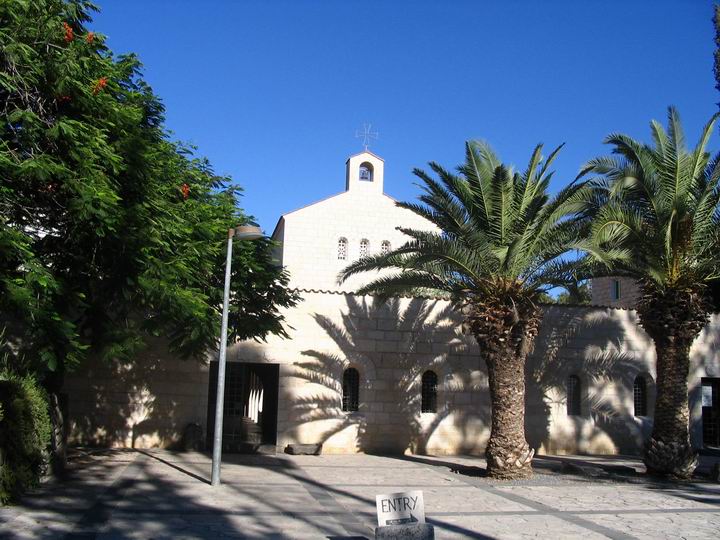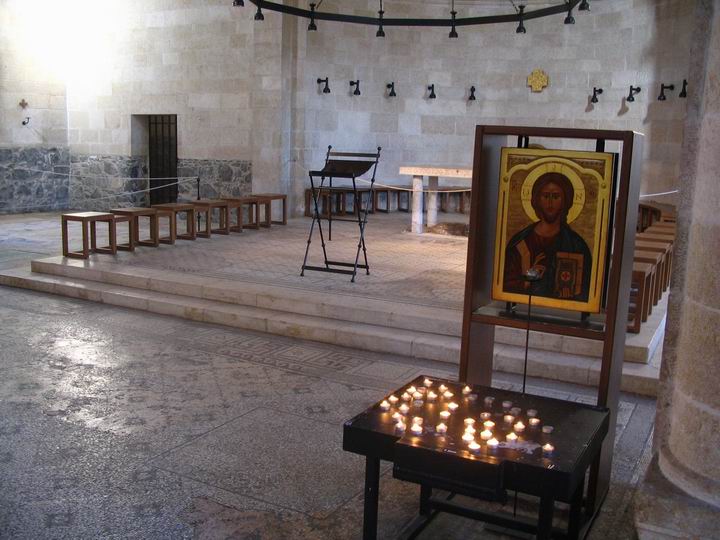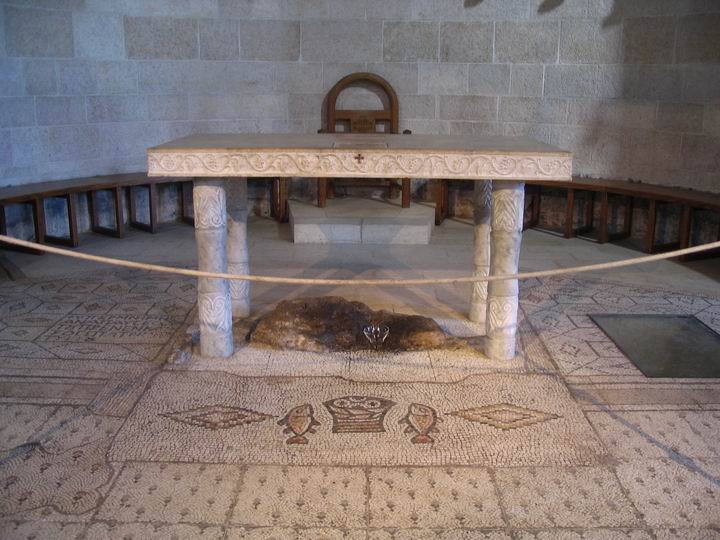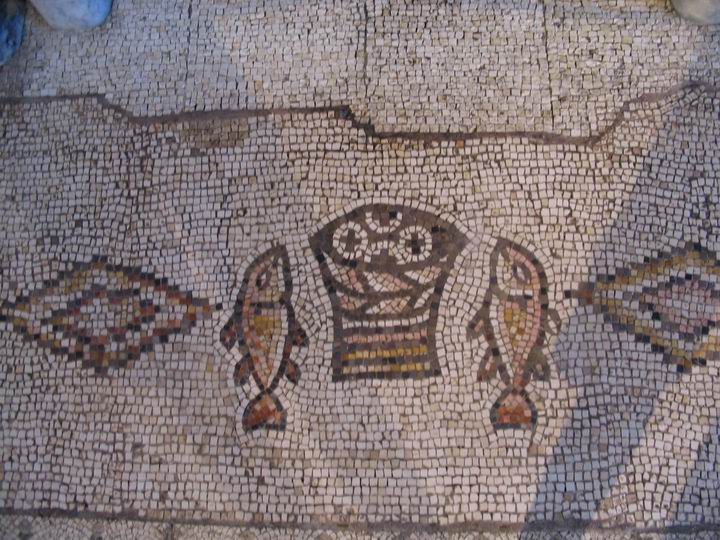Tabcha, or Ein Sheva, is a site on the north-west shore of the Sea of Galilee. In this site there is the Church of the first feeding of the Multitude, with beautiful mosaics of an old church, including the two fish and basket – the symbols of the miracle.
Home > Sites > Sea of Galilee > Tabcha (Tabgha, Ein Sheva, seven springs)
Contents:
Background
Location
History
Photos
Visit at the site
Biblical Refs
Etymology
Background:
Tabcha (Ein Sheva) is a place in the north-west section of the Sea of Galilee which is blessed by seven springs.
The area of Tabcha (Ein Sheva) was one of the best places in the Sea of Galilee for fishing. Some of the seven springs are warm sulfuric springs, such as Ein-Nur and Ein-Ayub (Job’s spring). This caused the fish to gather here, especially in the cold winter months, and so were an easy catch for the fishermen.
The waters from the springs were delivered to the fields and villages around using aqueducts. Near the springs there are pools that were used to raise the level of the water in order to deliver them via the aqueducts.
The waters were also used for powering water based bread mills. The last bread mill worked here until 1948.
The site is an important pilgrimage place: according to the tradition, Jesus performed here two miracles:
- first feeding of the multitude: feeding 5000 with 5 loaves of bread and two fish (Mathew 14: 13-21; Mark 6: 30-44; John 6: 1-15).
- apparition of Jesus to the Apostles after the resurrection (John 21, 1-17)
Location:
The area is located at the north-west corner of the Sea of Galilee, on the side of the ancient road from Tiberias to Damascus.
The seven springs was the west side of territory of the Roman village of Capernaum (Kefar Nachum in Hebrew), which is about 4KM away to the east.
This is the aerial view of the area from the south side. Tabcha is located to the east of the ancient site of Tell Kinneret.
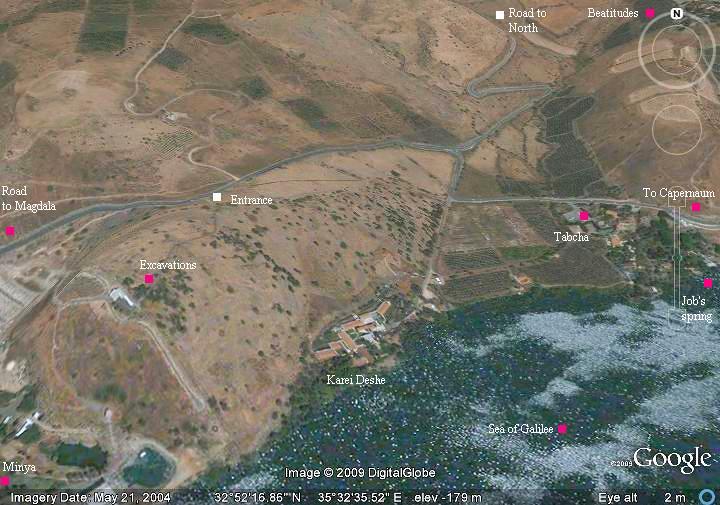
History:
In this site there is a church which was built over two earlier churches:
- the earlier one (from 350 AD) -its remnants can be seen on the right side of the altar below the glass cover.
- the later church (450 AD) was built towards the exact east, unlike the earlier church. Over many years the mosaic floor was laid out (there is an inscription in the floor dated about 480AD).
The Persian invasion (614AD) destroyed the site, which was in ruins until 1932 when the site has been excavated.
In 1982 the new Church was built around the old Churches, preserving the beauty and simplicity of the design, and glorifying the mosaic floor – one of the most impressive in the Holy Land.
Photos:
The following photo shows the front of the Church of the first Feeding of the Multitude at Tabcha. Its size is 33 x 56M, and it houses the two ancient churches.
Click on the photo to view it in higher resolution…
After passing an inner garden, then passing the inner Church doors, this is the view of the interior. The size of the inner church is 19M x 25M, and it is built over the floor of the ancient church from the 4th century AD. Under the raised altar was the foundations of the older Church from the 3rd century AD.
Most of the floor of the church is covered with the 4th century AD mosaics, based on stones of 1×1 cm in different colors.
In the front, under the altar, is a rock. This rock is believed to be the place on which Jesus laid the loaves. The old church was actually built around this rock.
Before the rock – the beautiful mosaic illustrating the two fish and basket with loaves. At the right of the altar is a glass protecting cover; under it lay the remnants of the foundations of the older ancient church (from 3rd century AD). At the left of the altar is an inscription of Patriarch Martyrios of Jerusalem (479-486) which is mentioned as the founder.
A closer view of the two fish and the basket:
Another detail of the mosaic floor is seen below. Most of the objects are water plants and water birds, scenes that are typical of the swamps of north-east area of the Sea of Galilee and Hula lake. The artist used the local scenery as the theme of the floor.
Visiting the site:
You can drive from Tiberias (7KM to the north). The site is located just after the large water pump facility in the north of the sea of Galilee.
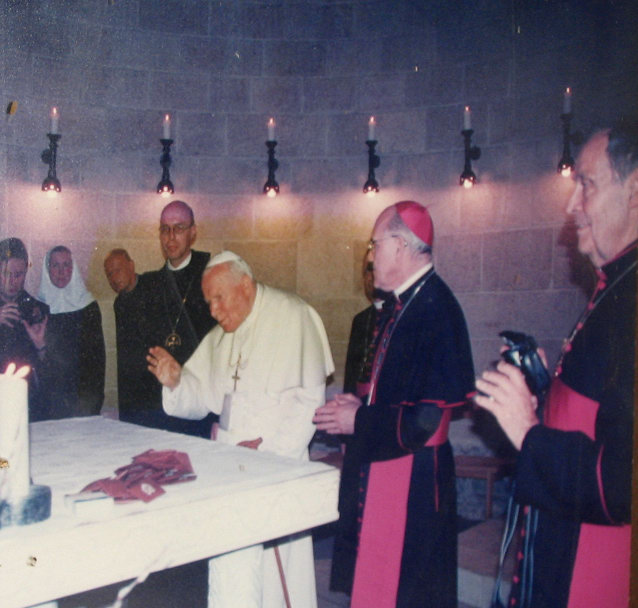
The late Joannes Paulus II visited here in March 24, 2000, as part of his Millennium visit.
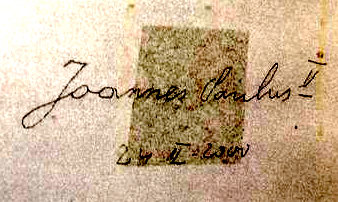
Biblical References:
(1) First feeding of the multitude
(1a) Mathew 14: 13-21:
“When Jesus heard of it, he departed thence by ship into a desert place apart: and when the people had heard thereof, they followed him on foot out of the cities. And Jesus went forth, and saw a great multitude, and was moved with compassion toward them, and he healed their sick. And when it was evening, his disciples came to him, saying, This is a desert place, and the time is now past; send the multitude away, that they may go into the villages, and buy themselves victuals. But Jesus said unto them, They need not depart; give ye them to eat. And they say unto him, We have here but five loaves, and two fishes. He said, Bring them hither to me. And he commanded the multitude to sit down on the grass, and took the five loaves, and the two fishes, and looking up to heaven, he blessed, and brake, and gave the loaves to his disciples, and the disciples to the multitude. And they did all eat, and were filled: and they took up of the fragments that remained twelve baskets full. And they that had eaten were about five thousand men, beside women and children”.
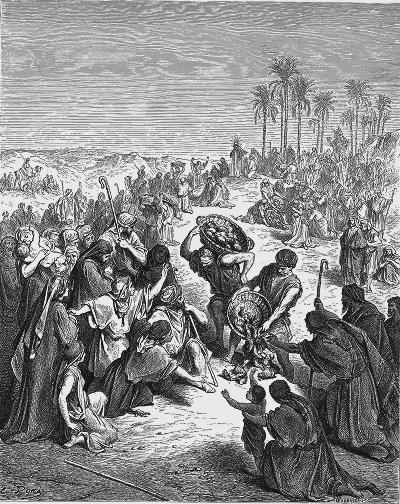
Feeding the multitude – Drawing by Gustav Dore (French artist, 1832-1883)
(1b) Mark 6: 30-44
“And the apostles gathered themselves together unto Jesus, and told him all things, both what they had done, and what they had taught. And he said unto them, Come ye yourselves apart into a desert place, and rest a while: for there were many coming and going, and they had no leisure so much as to eat. And they departed into a desert place by ship privately. And the people saw them departing, and many knew him, and ran afoot thither out of all cities, and outwent them, and came together unto him. And Jesus, when he came out, saw much people, and was moved with compassion toward them, because they were as sheep not having a shepherd: and he began to teach them many things. And when the day was now far spent, his disciples came unto him, and said, This is a desert place, and now the time is far passed: 6:36 Send them away, that they may go into the country round about, and into the villages, and buy themselves bread: for they have nothing to eat. He answered and said unto them, Give ye them to eat. And they say unto him, Shall we go and buy two hundred pennyworth of bread, and give them to eat? 6:38 He saith unto them, How many loaves have ye? go and see. And when they knew, they say, Five, and two fishes. And he commanded them to make all sit down by companies upon the green grass. And they sat down in ranks, by hundreds, and by fifties. And when he had taken the five loaves and the two fishes, he looked up to heaven, and blessed, and brake the loaves, and gave them to his disciples to set before them; and the two fishes divided he among them all. And they did all eat, and were filled. And they took up twelve baskets full of the fragments, and of the fishes. And they that did eat of the loaves were about five thousand men”.
(1c) John 6: 1-15
“After these things Jesus went over the sea of Galilee, which is the sea of Tiberias. And a great multitude followed him, because they saw his miracles which he did on them that were diseased. And Jesus went up into a mountain, and there he sat with his disciples. And the passover, a feast of the Jews, was nigh. When Jesus then lifted up his eyes, and saw a great company come unto him, he saith unto Philip, Whence shall we buy bread, that these may eat? And this he said to prove him: for he himself knew what he would do. Philip answered him, Two hundred pennyworth of bread is not sufficient for them, that every one of them may take a little. One of his disciples, Andrew, Simon Peter’s brother, saith unto him, There is a lad here, which hath five barley loaves, and two small fishes: but what are they among so many? And Jesus said, Make the men sit down. Now there was much grass in the place. So the men sat down, in number about five thousand. And Jesus took the loaves; and when he had given thanks, he distributed to the disciples, and the disciples to them that were set down; and likewise of the fishes as much as they would. When they were filled, he said unto his disciples, Gather up the fragments that remain, that nothing be lost. Therefore they gathered them together, and filled twelve baskets with the fragments of the five barley loaves, which remained over and above unto them that had eaten. Then those men, when they had seen the miracle that Jesus did, said, This is of a truth that prophet that should come into the world. When Jesus therefore perceived that they would come and take him by force, to make him a king, he departed again into a mountain himself alone”.
(2): Apparition of Jesus to the Apostles after the resurrection
(2a) John 21: 1-17
“After these things Jesus shewed himself again to the disciples at the sea of Tiberias; and on this wise shewed he himself. There were together Simon Peter, and Thomas called Didymus, and Nathanael of Cana in Galilee, and the sons of Zebedee, and two other of his disciples. Simon Peter saith unto them, I go a fishing. They say unto him, We also go with thee. They went forth, and entered into a ship immediately; and that night they caught nothing. But when the morning was now come, Jesus stood on the shore: but the disciples knew not that it was Jesus. Then Jesus saith unto them, Children, have ye any meat? They answered him, No. And he said unto them, Cast the net on the right side of the ship, and ye shall find. They cast therefore, and now they were not able to draw it for the multitude of fishes. Therefore that disciple whom Jesus loved saith unto Peter, It is the Lord. Now when Simon Peter heard that it was the Lord, he girt his fisher’s coat unto him, (for he was naked,) and did cast himself into the sea. And the other disciples came in a little ship; (for they were not far from land, but as it were two hundred cubits,) dragging the net with fishes. As soon then as they were come to land, they saw a fire of coals there, and fish laid thereon, and bread. Jesus saith unto them, Bring of the fish which ye have now caught. Simon Peter went up, and drew the net to land full of great fishes, an hundred and fifty and three: and for all there were so many, yet was not the net broken. Jesus saith unto them, Come and dine. And none of the disciples durst ask him, Who art thou? knowing that it was the Lord. Jesus then cometh, and taketh bread, and giveth them, and fish likewise. This is now the third time that Jesus shewed himself to his disciples, after that he was risen from the dead. So when they had dined, Jesus saith to Simon Peter, Simon, son of Jonas, lovest thou me more than these? He saith unto him, Yea, Lord; thou knowest that I love thee. He saith unto him, Feed my lambs. He saith to him again the second time, Simon, son of Jonas, lovest thou me? He saith unto him, Yea, Lord; thou knowest that I love thee. He saith unto him, Feed my sheep. He saith unto him the third time, Simon, son of Jonas, lovest thou me? Peter was grieved because he said unto him the third time, Lovest thou me? And he said unto him, Lord, thou knowest all things; thou knowest that I love thee. Jesus saith unto him, Feed my sheep”.
Etymology (behind the name):
-
Tabcha – from Arabic. The origin of the word is in Greek: Hepta-pegon, which means “seven springs”. In this area there are 7 springs, hence the name. Another theory attributes the number 7 to good luck, as in Beer-Sheba (the seven wells).
-
Similar: Tabgha
-
Ein Sheva – the name of the site in Hebrew, which means seven (Sheva, Sheba) springs (Ein).
-
Capernaum – from Hebrew: Kefar (village) + Nachum (a name of the prophet from the old testament).
Links and References:
BibleWalks:
- Job’s spring and cave
- Footsteps of Jesus – This pictorial presentation is arranged by BibleWalks staff.
BibleWalks.com – walk with us through the sites of the Holy Land
Magdala <<<–previous site—<<< All Sites>>>–-next Sea of Galilee site –>>> Jesus Boat
This page was last updated on Jan 14, 2021 (add larger photo of the 2 fish and basket)
Sponsored links:

